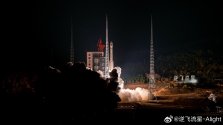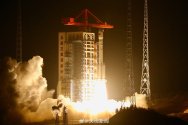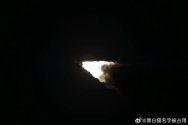You are using an out of date browser. It may not display this or other websites correctly.
You should upgrade or use an alternative browser.
You should upgrade or use an alternative browser.
China's Space Program Thread II
- Thread starter Blitzo
- Start date
by78
General
A LandSpace Zhuque-3 model. Check out the fairing size.

LandSpace confirms Zhuque-3 development is going smoothly, and the company aims to carry out its maiden launch around June of next year.

Dong Kai, the deputy chief designer of Zhuque-3, that LandSpace will conduct a full-scale ground test of Zhuque-3 in the first quarter of 2025. Three flights are planned for 2025, including a recovery of the 1st stage.

by78
General
The chief of Changguan Satellite Technology revealed in an that a new generation of optical and radar satellites are under active development. The company plans to rapidly expand its Jilin-1 constellation to 300 satellites by the end of 2026.


An on the Jilin-1 constellation. It now has 115 satellites in orbit, and over 90% of images taken have 0.5m resolution.

by78
General
China has released its medium- to long-term plan for space science (), outlining research priorities and a development roadmap in three phases.

The "National Medium- and Long-Term Development Plan for Space Science (2024-2050)," jointly released by the Chinese Academy of Sciences, China National Space Administration and China Manned Space Agency, identified five major scientific themes with 17 priority areas for future breakthroughs:
· "Extreme universe" – Exploring the origin and evolution of the universe and revealing the physical laws under extreme cosmic conditions. Key areas under this theme include dark matter and extreme universes, the origin and evolution of the universe, and the detection of baryonic matter in the universe.
· "Space-time ripples" – Detecting low-frequency gravitational waves and primordial gravitational waves, and uncovering the nature of gravity and space-time. The priority is the detection of gravitational waves in space.
· "Panorama of the Earth and sun" – Studying the Earth, the sun and the heliosphere, and unveiling the complex sun-Earth system as well as the physical processes and laws of overall connection between the sun and the solar system. Priority directions include the Earth circulation system, comprehensive Earth-moon observation, space weather detection, solar stereoscopic exploration and outer heliosphere exploration.
· "Habitable planets" – Accessing the habitability of solar system bodies and exoplanets while searching for extraterrestrial life. Priority areas include sustainable development, solar system archaeology, characterization of planetary layers, extraterrestrial life searches and exoplanet exploration.
· "Biological and physical space science" – Revealing the laws of matter movement and life activities under space conditions, and deepening the understanding of fundamental physics such as quantum mechanics and general relativity. Key areas include microgravity science, quantum mechanics, general relativity, and space life sciences.
The plan also outlined a three-stage development roadmap through 2050.
The first stage is from now till 2027 that the country should maintain the operation of its space station, and carry out manned lunar exploration, the fourth phase of the lunar exploration project and the planetary exploration project. It also includes validating and approving five to eight space science satellite missions, forming a number of original achievements with significant international impact.
The second stage is from 2028 to 2035. Besides operating the space station and conducting scientific missions such as manned lunar exploration and building the international lunar scientific research station, the country should implement about 15 space science satellite missions, achieving original achievements that rank the world's top.
The last stage runs through 2036 to 2050, when more than 30 space science missions would be implemented, with significant advancements in key areas reaching a world-leading level.
Using spacecraft as the primary platform, space science focuses on studying natural phenomena and their laws, including physical, chemical, and biological processes that occur in the sun-Earth space, interplanetary space, and throughout the universe. It addresses some of the most challenging fundamental questions and significant scientific issues of the time, such as the nature of dark matter and dark energy, the origins of the universe, the mysteries of extraterrestrial life, the evolution of the solar system and planets, and sun-Earth connections.

Can see the article about it here. So, they've done 2 launches of G60 now and still no Guowang.
Since they want to complete phase 1 of 648 satellites by end of 2025, they will need to pick up the pace. They need to launch 612 satellites in 14 months -> >40 per month.
From news reporting on first launch, they can do 36 per launch in the future. So, they need to do 1 to 2 launch a month for the next while and start launching 36 satellite launches.
it will be mind boggling if China achieve this on time.. 
Manned lunar landing by 2027 and the start of the construction of lunar base by 2028..
The "National Medium- and Long-Term Development Plan for Space Science (2024-2050)," jointly released by the Chinese Academy of Sciences, China National Space Administration and China Manned Space Agency, identified five major scientific themes with 17 priority areas for future breakthroughs ..
Manned lunar landing by 2027 and the start of the construction of lunar base by 2028..
The "National Medium- and Long-Term Development Plan for Space Science (2024-2050)," jointly released by the Chinese Academy of Sciences, China National Space Administration and China Manned Space Agency, identified five major scientific themes with 17 priority areas for future breakthroughs ..
Reading the Chinese version, I think that you might have misunderstood. The first phase implementing manned lunar exploration program does not mean they will land on the moon surface by 2024, everything they are doing including developping the lander and CZ-10 is part of the program implementation. CZ-10's maiden flight in 2027 is the mark of completion of the phase.it will be mind boggling if China achieve this on time..
Manned lunar landing by 2027 and the start of the construction of lunar base by 2028..
The "National Medium- and Long-Term Development Plan for Space Science (2024-2050)," jointly released by the Chinese Academy of Sciences, China National Space Administration and China Manned Space Agency, identified five major scientific themes with 17 priority areas for future breakthroughs ..
The second phase used the words "study" and "implement". The means moon landing execution and studying and implementation moon station.
In short, there is nothing changed from already announced. Chinese language version should always be regarded as the only authoritive source.

such clarity from a satilite kms above mother earth!An on the Jilin-1 constellation. It now has 115 satellites in orbit, and over 90% of images taken have 0.5m resolution.





